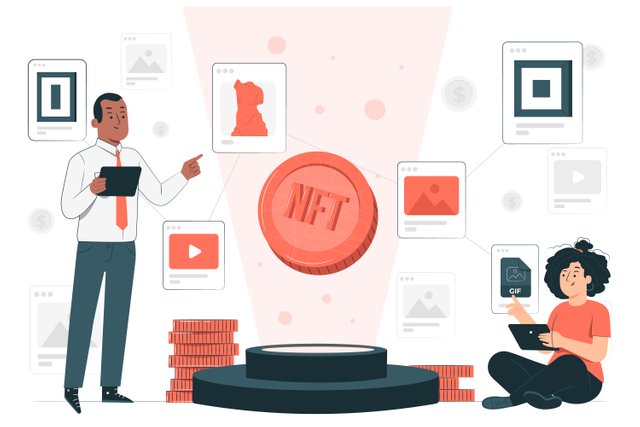
In recent years, the world of digital art and collectibles has undergone a significant transformation. The emergence of Non-Fungible Tokens (NFTs) has revolutionized the way we perceive and interact with digital assets. While NFTs have gained widespread attention and popularity, the evolution of this technology into NFT 2.0 is poised to take the digital landscape by storm. In this article, we will delve into the exciting world of NFT 2.0 and explore how it is reshaping the future.
What are NFTs?
Before we dive into NFT 2.0, let's briefly discuss what NFTs are. NFTs are unique digital assets that are stored on a blockchain, typically utilizing Ethereum's blockchain. Unlike cryptocurrencies such as Bitcoin or Ethereum, which are fungible and can be exchanged on a like-for-like basis, NFTs are indivisible and represent ownership or proof of authenticity of a particular digital item.
The Rise of NFTs
NFTs gained significant traction in 2021 when digital artworks, virtual real estate, and even tweets were sold for millions of dollars. This explosion in popularity brought attention to the possibilities that NFTs offered for creators and collectors alike. The ability to tokenize and sell digital assets with verifiable ownership rights opened up a whole new world of opportunities.
NFT 2.0: The Next Evolution
NFT 2.0 represents the next phase of development and innovation in the NFT space. It builds upon the foundations laid by NFTs and introduces new features and capabilities that enhance the overall user experience and offer new avenues for creativity and collaboration.
Enhanced Interoperability
One of the key advancements in NFT 2.0 is enhanced interoperability. NFT 2.0 allows for seamless transfer and compatibility of digital assets across different blockchains. This means that artists and collectors are no longer limited to a single blockchain and can explore various platforms and ecosystems, expanding their reach and audience.
Scalability and Reduced Costs
NFT 2.0 also addresses the scalability issues faced by NFTs. The high gas fees associated with Ethereum-based NFTs have been a barrier for many artists and collectors. However, with the introduction of NFT 2.0, solutions such as Layer 2 protocols and blockchain interoperability enable faster and more cost-effective transactions, making NFTs more accessible to a wider audience.
Fractional Ownership and Liquidity
Another intriguing feature of NFT 2.0 is the notion of fractional ownership. Fractional ownership enables several individuals to collectively own a portion of an NFT, thereby increasing accessibility to valuable assets for a wider range of collectors. Moreover, NFT 2.0 introduces liquidity options, empowering owners to trade or sell fractions of their NFTs, thus amplifying the financial possibilities of digital assets. This expansion also encompasses the integration of an NFT Marketplace for Digital Assets.
Smart Contracts and Dynamic NFTs
Smart contracts play a vital role in NFT 2.0. They allow for programmable functionality and dynamic NFTs, enabling digital assets to evolve and respond to certain conditions or events. For example, a dynamic NFT could change its appearance based on real-time data or interact with other NFTs within a collection, creating unique and interactive experiences for collectors.
Enhanced Copyright Protection
Copyright protection has been a concern in the digital space, especially with the ease of replicating and sharing digital content. NFT 2.0 addresses this by embedding copyright information directly into the NFT, ensuring that artists' rights are protected and acknowledged. This feature adds an extra layer of authenticity and value to digital assets.
The Democratization of Creativity
NFT 2.0 has the potential to democratize creativity by empowering artists and creators. With reduced costs, increased interoperability, and fractional ownership options, artists can reach a global audience and monetize their work more easily. This new paradigm enables a direct relationship between creators and collectors, bypassing traditional intermediaries and empowering individual artists.
The Future of NFT 2.0
As NFT 2.0 continues to evolve, we can expect to see further innovations and advancements in the digital landscape. From virtual reality experiences to gamified NFTs, the possibilities are vast. The future of NFT 2.0 holds immense potential to reshape not only the art and collectibles industry but also various other sectors such as gaming, virtual real estate, and even identity verification.
Conclusion
NFT 2.0 represents the next phase in the evolution of digital assets and their impact on the digital landscape. With enhanced interoperability, reduced costs, fractional ownership, dynamic functionality, copyright protection, and the democratization of creativity, NFT 2.0 is poised to transform the way we create, own, and interact with digital content. As this technology continues to mature and innovate, we can expect to witness exciting developments that shape the future of the digital world we inhabit. The future is now, and NFT 2.0 is leading the way.